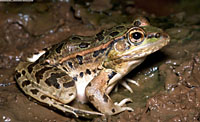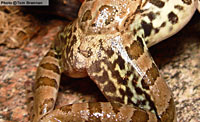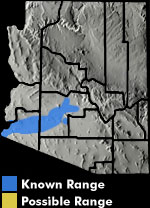Online Field Guide to The Reptiles and Amphibians of Arizona


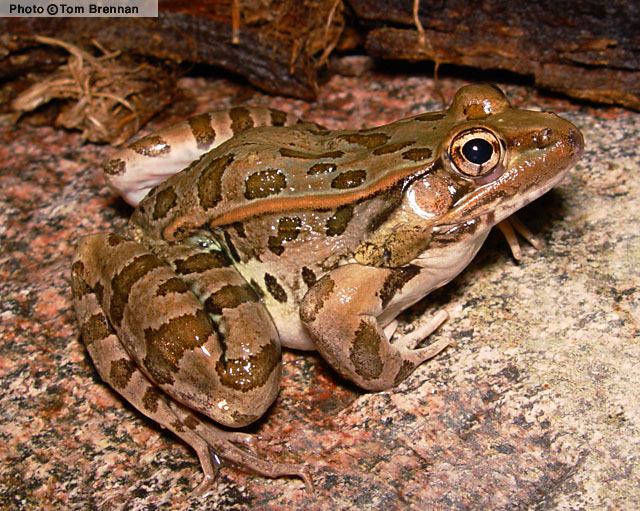
Maricopa County, AZ
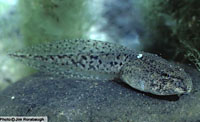 Tadpole. Arizona. |
| RIO GRANDE LEOPARD FROG Lithobates berlandieri | |
|
DESCRIPTION: A moderate to large (up to about 4.5 inches in length) leopard frog. The dorsum typically has numerous dark spots and raised dorsolateral folds on a background of brown, grayish, bronze, green, or olive green, or a combination of these colors. Individuals occasionally lack spots. The ventral surface is cream-colored, sometimes with a dusky wash on the throat. This species is distinguished from other Arizona leopard frogs by discontinuous dorsolateral folds that are inset towards the rear; a bold, dark reticulation on the rear of the thighs; prominent vocal sacs on adult breeding males; usually an absence of spots on the snout; and an incomplete light lip or supralabial stripe. Tadpoles are light-colored and mottled and may reach 3.75 inches total length. DISTRIBUTION: Occurs along southwestern Arizona rivers and adjacent agricultural lands from the Salt River near the 101/202 freeway interchange and the Agua Fria River just below Lake Pleasant downstream through the lower Gila River Valley to the lower Colorado River, where it ranges from Mittry Lake south into Mexico. The Rio Grande leopard frog is expanding its range. HABITAT: In Arizona, it is primarily a frog of big rivers, backwaters, drainage ditches, unlined and occasionally lined canals, agricultural sumps, and occasionally stock tanks or other water bodies. These wetted areas are surrounded by Sonoran Desertscrub. Unlike native leopard frogs, this species coexists well with a suite of introduced predators (e.g. American bullfrogs, crayfish, sport fishes). BEHAVIOR: Can be found active day or night, although they are much easier to find and observe at night with a headlamp or flashlight. Active nearly year-round, this species hibernates on the bottom of ponds or ditches with slow-moving water on the coldest days of winter. DIET: Like other Arizona ranids, this species will eat a variety of invertebrate and vertebrate, aquatic and terrestrial prey. REPRODUCTION AND CALLS: Breeding occurs probably from February into November, but is most common in the spring and early summer. Egg masses up to 3.5 inches across are deposited in quiet water. Some tadpoles overwinter. Males have a loud, rattling advertisement call that is audible for a quarter of a mile or more in some situations. REMARKS: The Rio Grande leopard frog was introduced to southwestern Arizona probably in the late 1960’s or 1970’s from New Mexico or west Texas. They may have hitchhiked with loads of sport fishes from a warm-water fish hatchery. If it continues to spread upstream in the Salt and Agua Fria drainages, it will likely prey upon and compete with native leopard frogs. Brennan, T.C., & Holycross, A.T. 2006. A Field Guide to Amphibians and Reptiles in Arizona. Arizona Game and Fish Department. Phoenix, AZ. Degenhardt, W.G., C.W. Painter, and A.H. Price. 1996. Amphibians and reptiles of New Mexico. University of New Mexico Press, Albuquerque. Rorabaugh, J.C. 2005. Rana berlandieri Baird, 1854, Rio Grande leopard frog. Pages 530-532 in M.J. Lannoo (ed), Amphibian Declines: The Conservation Status of United States Species. University of California Press, Berkeley. Rorabaugh, J.C., M.J. Sredl, V. Miera, and C.A. Drost. 2002. Continued invasion by an introduced frog, Rana berlandieri: Southwestern Arizona, southeastern California, and Rio Colorado, Mexico. The Southwestern Naturalist 47(1):12-20. Stebbins, R.C. 2003. A Field Guide to Western Reptiles and Amphibians, Third Edition. Houghton Mifflin Company, Boston, MA. |
|
Visit Partners in Amphibian and Reptile Conservation:


HOME
Copyright © 2023, Arizona Game and Fish Department. All rights reserved.
If you make use of the textual contents of this site in reports, publications, etc. please cite and credit the author(s) and photographer(s). All photos on this website are copyrighted. However, those found in the species account section may be used for any noncommercial scientific, educational, or conservation purposes provided that photographs are not altered and continue to bear the copyright symbol and name of the photographer. Please contact the photographer regarding commercial use of copyrighted photographs.










